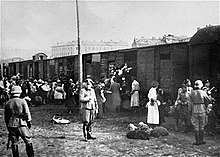Transshipment point at the Warsaw Ghetto
The trading center in Warsaw was during the Holocaust the place in the Warsaw Ghetto , where the Jews for deportation mostly to the Treblinka extermination camp were gathered or rounded. It was the freight yard of the Danzig train station , consisting of tracks with goods sheds, storage areas and various loading tracks. The freight yard is no longer in operation today.
The western area of the station, which is directly connected to the ghetto, was separated from the rest of the station with a wooden fence and later with a wall. Various platforms, railway buildings, the former homeless shelter, a hospital and other buildings have been converted into a transit area for the prisoners. Also found selections instead of the prisoners of the ghetto.
On July 22, 1942, the National Socialists began to transport the Jews of Warsaw crowded together in freight cars. On some days 7,000 Jews were deported and a total of around 265,000 were brought to the gas chambers . Some sources describe it as the greatest mass murder by a single community in World War II . The transports initially ended on September 12, 1942. Individual transports followed. The next wave was supposed to begin on January 18, 1943, which initially did not occur due to the resistance actions on three days prior to the uprising in the Warsaw ghetto .
During the deportations, the rest of the station area served as a trading and supply center for large parts of the rest of the city.
memorial
On April 18, 1988, on the eve of the 45th anniversary of the start of the Warsaw Ghetto uprising, a stone monument resembling an open freight car was erected at the transshipment point on Stawki Street. It was designed by the architect Hanna Szmalenberg and the sculptor Władysław Klamerus . The inscription on the monument is in Hebrew, Polish and English:
" Between 1942 and 1943, more than 300,000 Jews were driven from the Warsaw ghetto to the gas chambers of the Nazi extermination camps via this path of suffering and death "
The four hundred most common Jewish-Polish first names from Aba to Żanna are engraved on the monument. In 2002 the monument was added to the list of historical monuments.
In culture
Umschlagplatz plays an important role in the autobiography The Pianist - My Wonderful Survival (original title: Śmierć miasta ) by the Polish pianist and composer Władysław Szpilman, published in 1946 . In the film adaptation ( The Pianist ) of the book by Roman Polanski , the Umschlagplatz is also shown.
The Polish writer Jarosław Marek Rymkiewicz , born in Warsaw in 1935, created an important literary monument to this place: Umschlagplatz .
See also
literature
- Jarosław Marek Rymkiewicz: Umschlagplatz . Berlin: Rowohlt, 1993, ISBN 978-3871340598 .
Individual evidence
- ↑ Wiesław Głębocki, Warszawskie pomniki , Wydawnictwo PTTK "Kraj", Warszawa 1990, p. 108.
- ↑ zabytów nieruchomych - Warszawa ( Memento of the original of September 13, 2012 in the Internet Archive ) Info: The archive link has been inserted automatically and has not yet been checked. Please check the original and archive link according to the instructions and then remove this notice. Narodowy Instytut Dziedzictwa, p. 47, Retrieved August 11, 2012.
Web links
Coordinates: 52 ° 15 '8.3 " N , 20 ° 59' 20.7" E

